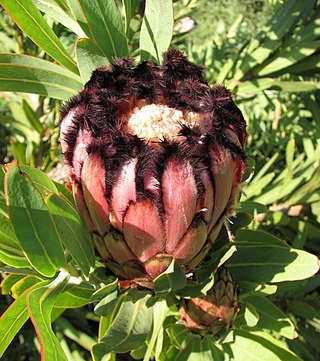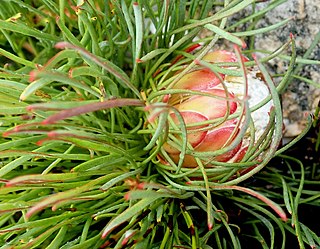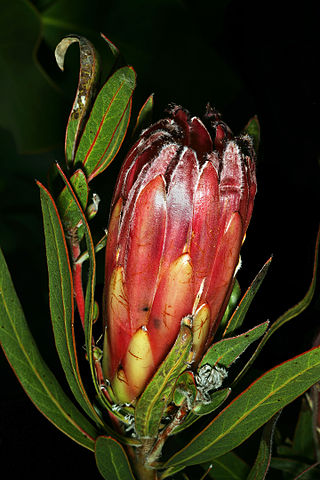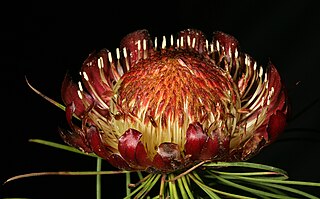
Protea neriifolia, also known as the narrow-leaf sugarbush, oleander-leaved sugarbush, blue sugarbush, or the oleanderleaf protea, is a flowering plant in the genus Protea, which is endemic to South Africa.

Protea acaulos, also known as the common ground sugarbush, is a flowering plant found in the southwestern Cape Region, South Africa. It is also simply known as ground protea; in the Afrikaans language it is known as an aardroos.

Protea magnifica, commonly known as the queen protea, is a shrub, which belongs to the genus Protea within the family Proteaceae, and which is native to South Africa.

Protea pendula, also known as the nodding sugarbush or arid sugarbush, is a flowering plant of the genus Protea, in the family Proteaceae, which is only found growing in the wild in the Cape Region of South Africa. In the Afrikaans language it is known as knikkopsuikerbossie or ondersteboknopprotea.

Protea recondita, also known as the hidden sugarbush, is a flowering plant of the genus Protea within the family Proteaceae, which is endemic to the Cape Region of South Africa, and distributed from the Piketberg and Cederberg to the Groot Winterhoek mountains. The flowers of this unusual plant are pollinated by non-flying mammals: rodents and elephant shrews. In the Afrikaans language it is known as gesigtoehouprotea or skaamroos.

Protea sulphurea, also known as the sulphur sugarbush, is a flowering plant of the genus Protea in the family Proteaceae, which is only known to grow in the wild in the Western Cape province of South Africa. A vernacular name for the plant in the Afrikaans language is heuningkoeksuikerbos or Skaamblom.

Protea foliosa, also known as the leafy sugarbush, is a flowering plant of the genus Protea in the family Proteaceae which is endemic to the Cape Region of South Africa. In the Afrikaans language it is known as ruie-suikerbos.

Protea intonsa, also known as the tufted sugarbush, is a flowering plant of the genus Protea within the family Proteaceae, endemic to South Africa, where it is distributed from the eastern Swartberg and Kammanassie Mountains to the Baviaanskloof mountains. In Afrikaans it is known as klossie-suikerbos.

Protea montana also known as the Swartberg sugarbush, is a flowering plant of the genus Protea within the family Proteaceae, which is endemic to the southwestern Cape Region of South Africa. In Afrikaans it is known as swartbergsuikerbos.

Protea rubropilosa, also known as the Transvaal sugarbush, escarpment sugarbush or Transvaal mountain sugarbush, is a flowering tree, that belongs to the genus Protea in the family Proteaceae. The plant only occurs in South Africa.

Protea dracomontana, the Nyanga protea or the Drakensberg sugarbush, is a flowering plant that belongs within the genus Protea. The plant is found in the Eastern Cape, Lesotho, KwaZulu-Natal and the escarpment of the Free State, as well as eastern Zimbabwe. In Zimbabwe this species is only known from a disjunct subpopulation confined to the summit of Mount Nyangani.

Protea pudens, also known as the bashful sugarbush, is a low-growing, groundcover-like, flowering shrub in the genus Protea. It is only found growing in the wild in a small area in the Western Cape province of South Africa.

Protea burchellii, also known as Burchell's sugarbush, is a flowering shrub in the genus Protea, which is endemic to the southwestern Cape Region of South Africa.

Protea speciosa, also known as the brown-beard sugarbush, is a flowering shrub which is classified as within the genus Protea.

Protea pityphylla, also known as Ceres sugarbush or mountain rose, is a flowering shrub of the genus Protea, in the family Proteaceae. The plant is endemic to the southwestern Cape Region of South Africa.

Protea lorifolia, in English called the strap-leaved sugarbush, strap-leaved protea or strap-leaf sugarbush is a flowering shrub which belongs to the genus Protea.

Protea laevis, also known as the smooth-leaf sugarbush, is a flowering shrub that belongs within the genus Protea.

Protea convexa, also known as large-leaf sugarbush, is a rare flowering shrub in the genus Protea of the family Proteaceae, which is endemic to the southwestern Cape Region of South Africa.

Protea caespitosa, also known as hottentot bishop sugarbush or bishop sugarbush, is a flowering shrub belonging to the genus Protea which is only found growing in the wild in South Africa.

Protea decurrens, also known as linear-leaf sugarbush, is a shrub of the genus Protea, in the Proteaceae family, which is endemic to the southwestern Cape Region of South Africa. It is a small shrub with a thick underground rootstock, this structure throwing up numerous leafy branches, upon the base of which clusters of flower heads may appear close to the ground. It is pollinated by rodents and grows in low-altitude fynbos or renosterveld.






















